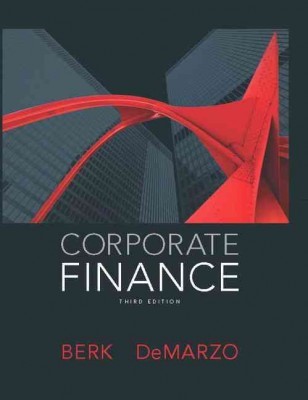Description
Corporate Finance Berk 3rd Edition Solutions Manual
Corporate Finance Berk 3rd Edition Solutions Manual
Corporate Finance Berk DeMarzo 3rd Edition Solutions Manual
Corporate Finance Berk DeMarzo 3rd Edition Solutions Manual
***THIS IS NOT THE ACTUAL BOOK. YOU ARE BUYING the Solution Manual in e-version of the following book***
Name: Corporate Finance
Author: Berk DeMarzo
Edition: 3rd
ISBN-10: 0133424154
Type: Solutions Manual
– The file contains solutions and questions to all chapters and all questions. All the files are carefully checked and accuracy is ensured.
– The file is either in .doc, .padf, excel, or zipped in the package and can easily be read on PCs and Macs.
– Delivery is INSTANT. You can download the files IMMEDIATELY once payment is done.
If you have any questions, please feel free to contact us. Our response is the fastest. All questions will always be answered in 6 hours., most of the time within 30mins
We also faced similar difficulities when we were students, and we understand how you feel.
But now, with the Corporate Finance Solution Manual, you will be able to
* Have your homework problems solved readily.
* Reduces the hassle and stress of your student life.
* Improve your studying and also get a better grade!
* Get prepared for examination questions.
*Can save you time and help you understand the material.
This is the quality of service we are providing and we hope to be your helper.
Delivery is in the next moment. Solution Manual is accurate.
Prepare to receive your Corporate Finance Solution Manual in the next moment.
If you have any questions, or would like a receive a sample chapter before your purchase, please contact us at inquiry@testbankcorp.com
Corporate Finance Solution Manual
Corporate Finance 3rd Solution Manual
Corporate Finance 3rd Berk DeMarzo Solutions Manual
Corporate Finance Berk DeMarzo 3rd Edition Solutions Manual ISBN: 0133424154
PART I. INTRODUCTION
1. The Corporation
2. Introduction to Financial Statement Analysis
3. The Law of One Price and Financial Decision Making
PART II. TIME, MONEY, AND INTEREST RATES
4. The Time Value of Money
5. Interest Rates
6. Valuing Bonds
PART III. VALUING PROJECTS AND FIRMS
7. Investment Decision Rules
8. Fundamentals of Capital Budgeting
9. Valuing Stocks
PART IV. RISK AND RETURN
10. Capital Markets and the Pricing of Risk
11. Optimal Portfolio Choice and the Capital Asset Pricing Model
12. Estimating the Cost of Capital
13. Investor Behavior and Capital Market Efficiency
PART V. CAPITAL STRUCTURE
14. Capital Structure in a Perfect Market
15. Debt and Taxes
16. Financial Distress, Managerial Incentives, and Information
17. Payout Policy
PART VI. ADVANCED VALUATION
18. Capital Budgeting and Valuation with Leverage
19. Valuation and Financial Modeling: A Case Study
PART VII. OPTIONS
20. Financial Operations
21. Option Valuation
22. Real Options
PART VIII. LONG-TERM FINANCING
23. Raising Equity Capital
24. Debt Financing
25. Leasing
PART IX. SHORT-TERM FINANCING
26. Working Capital Management
27. Short-Term Financial Planning
PART X. SPECIAL TOPICS
28. Mergers and Acquisitions
29. Corporate Governance
30. Risk Management
31. International Corporate Finance
Chapter 1
The Corporation
1-1. What is the most important difference between a corporation and all other organizational forms?
A corporation is a legal entity separate from its owners.
1-2. What does the phrase limited liability mean in a corporate context?
Owners’ liability is limited to the amount they invested in the firm. Stockholders are not responsible for any encumbrances of the firm; in particular, they cannot be required to pay back any debts incurred by the firm.
1-3. Which organizational forms give their owners limited liability?
Corporations and limited liability companies give owners limited liability. Limited partnerships provide limited liability for the limited partners, but not for the general partners.
1-4. What are the main advantages and disadvantages of organizing a firm as a corporation?
Advantages: Limited liability, liquidity, infinite life
Disadvantages: Double taxation, separation of ownership and control
1-5. Explain the difference between an S corporation and a C corporation.
C corporations must pay corporate income taxes; S corporations do not pay corporate taxes, but must pass through the income to shareholders to whom it is taxable. S corporations are also limited to 75 shareholders and cannot have corporate or foreign stockholders.
1-6. You are a shareholder in a C corporation. The corporation earns $2 per share before taxes. Once it has paid taxes it will distribute the rest of its earnings to you as a dividend. The corporate tax rate is 40% and the personal tax rate on (both dividend and non-dividend) income is 30%. How much is left for you after all taxes are paid?
First, the corporation pays the taxes. After taxes, is left to pay dividends. Once the dividend is paid, personal tax must be paid, which leaves . So, after all the taxes are paid, you are left with 84¢.
1-7. Repeat Problem 6 assuming the corporation is an S corporation.
An S corporation does not pay corporate income tax. So it distributes $2 to its stockholders. These stockholders must then pay personal income tax on the distribution. So they are left with .
1-8. You have decided to form a new start-up company developing applications for the iPhone. Give examples of the three distinct types of financial decisions you will need to make.
As the manager of an iPhone applications developer, you will make three types of financial decisions.
i. You will make investment decisions such as determining which type of iPhone application projects will offer your company a positive NPV and that your company, therefore, should develop.
ii. You will make the decision on how to fund your iPhone application investments and what mix of debt and equity your company will have.
iii. You will be responsible for the cash management of your company, ensuring that your company has the necessary funds to make investments, pay interest on loans, and pay your employees.
1-9. When a pharmaceutical company develops a new drug, it often receives patent protection for that medication, allowing it to charge a higher price. Explain how this public policy of providing patent protection might help align the corporation’s interests with society’s interests.
Without patent protection, the developer of the drug would be forced to lower prices to compete with generic manufacturers. Because this price competition would lower expected future profits, the developer would be willing to spend much less in R&D to develop the drug initially, and drug innovation would be curtailed.
Alternatively, by allowing the drug’s developer to earn higher profits that are commensurate with the value of the drug to society, drug developers will find it in their best interests to spend more on R&D, and drug innovation is enhanced. Thus, patent protection can align the corporation’s and society’s interests and provide for more efficient spending on drug R&D.
1-10. Corporate managers work for the owners of the corporation. Consequently, they should make decisions that are in the interests of the owners, rather than their own. What strategies are available to shareholders to help ensure that managers are motivated to act this way?
Shareholders can do the following.
i. Ensure that employees are paid with company stock and/or stock options.
ii. Ensure that underperforming managers are fired.
iii. Write contracts that ensure that the interests of the managers and shareholders are closely aligned.
iv. Mount hostile takeovers.
1-11. Suppose you are considering renting an apartment. You, the renter, can be viewed as an agent while the company that owns the apartment can be viewed as the principal. What principal-agent conflicts do you anticipate? Suppose instead that you work for the apartment company. What features would you put into the lease agreement that would give the renter incentives to take good care of the apartment?
The agent (renter) will not take the same care of the apartment as the principal (owner), because the renter does not share in the costs of repairing damage to the apartment. To mitigate this problem, having the renter pay a deposit should motivate the renter to keep damages to a minimum. The deposit forces the renter to share in the costs of repairing any problems that they cause.
1-12. You are the CEO of a company and you are considering entering into an agreement to have your company buy another company. You think the price might be too high, but you will be the CEO of the combined, much larger, company. You know that when the company gets bigger, your pay and prestige will increase. What is the nature of the agency conflict here and how is it related to ethical considerations?
There is an ethical dilemma when the CEO of a firm has the opposite incentives to those of the shareholders. In this case, you (as the CEO) have an incentive to potentially overpay for another company (which would be damaging to your shareholders) because your pay and prestige will improve.
1-13. Are hostile takeovers necessarily bad for firms or their investors? Explain.
No. They are a way to discipline managers who are not working in the interests of shareholders.
1-14. What is the difference between a public and private corporation?
The shares of a public corporation are traded on an exchange (or “over the counter” in an electronic trading system) while the shares of a private corporation are not traded on a public exchange.
1-15. Explain why the bid-ask spread is a transaction cost.
Investors always buy at the ask and sell at the bid. Since ask prices always exceed bid prices, investors “lose” this difference. It is one of the costs of transacting. Since the market makers take the other side of the trade, they make this difference.
1-16. The following quote on Yahoo! Stock appeared on July 9, 2012, on Yahoo! Finance:
If you wanted to buy Yahoo!, what price would you pay? How much would you receive if you wanted to sell Yahoo!?
You would buy at $15.78 and sell for $15.77.







Reviews
There are no reviews yet.